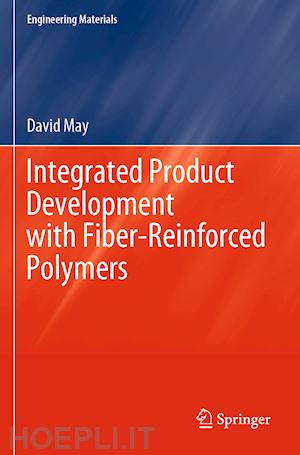
Questo prodotto usufruisce delle SPEDIZIONI GRATIS
selezionando l'opzione Corriere Veloce in fase di ordine.
Pagabile anche con Carta della cultura giovani e del merito, 18App Bonus Cultura e Carta del Docente
This book presents the basics of fiber reinforced polymers (FRP). The author presents the material-specific advantages of FRP and the typical areas of their application. The problems created by conventional, non-integrating product development are listed and the author states how these problems are potentially overcome by integrated product development (IPD). In addition, it is explained why IPD is of particular importance for FRP. An approach to IPD for FRP-parts is presented. It is explained step by step how a catalogue of requirements is defined as well as how this basis is used to develop a concept, a design, and a final construction. Simple but effective methods for the selection of fiber materials, semi-finished products and manufacturing processes are highlighted in this book. A concluding chapter describes an approach to techno-economic evaluation. Throughout the book, practical application examples show the reader how to put the gained knowledge into practice.
Content I
List of used akronyms. V
List of used formula symbols (latin) IX
List of used formula symbols (greek) XIV
Preface. 11...... Introduction.. 3
1.1 Abstract 3
1.2 Basic mechanicle principle of Fiber-reinforced Polymers (FRP) 3
1.3 Applications of FRP.. 7
1.4 Product Development vs. Integrated Product Development (IPD) 15
1.5 Methods of IPD.. 19
1.6 Relevance of IPD for FRP.. 22
1.7 Questions. 25
1.8 References. 26
2...... Realization of an Integrated Product Development 30
2.1 Abstract 30
2.2 The development team.. 30
2.3 Procedure and division of tasks for the IPD with FRP.. 35
3...... Phase 1: Definition of the Catalogue of Requirements. 443.1 Abstract 44
3.2 Overview.. 44
3.3 Types and sources for requirements. 45
3.4 Risks when defining requiremtens. 47
3.5 Tools the identification and specification of requriements. 49
3.5.1 Guideline with main list of characteristics. 50
3.5.2 Szenario technique. 52
3.5.3 Identification of functions and functional structures. 53
3.6 Guidelines and requriement catalogues for FRP-components. 55
3.6.1 Guidline „Design“ 55
3.6.2 Guideline „Manufacturing“ 57
3.6.3 Guideline “Materials” 59
3.6.4 Full catalogue of requirements. 60
3.7 Questions. 64
3.8 References. 64
4...... Phase 2: Concept & Draft 66
4.1 Abstract 66
4.2 Overview.. 66
4.3 Basics of product development with FRP.. 674.3.1 Relevance of Fiber volume content 67
4.3.2 Relevance of fiber length and orientation.. 69
4.3.3 Laminate built-up. 73
4.3.4 Laminate coding. 80
4.3.5 FRP-design principles. 82
4.3.6 Advantages and disadvantages of FRP.. 86
4.4 Definition of critical load cases and derivation of requriement for geometry and material 87
4.5 Selection of fiber material and structure of fiber reinforcement 92
4.5.1 Fiber materials. 92
4.5.2 Structure of fiber reinforcement 97
4.5.3 Material properties for initial design.. 99
4.5.4 Selcetion procedure. 107
4.6 Initial design.. 115
4.7 Development of a manufacturing concept 1164.7.1 Basics of FRP manufacturing. 117
4.7.2 Manufacturing processes. 119
4.7.3 Process selection.. 152
4.8 Decision concerning polymer class: thermoplastic or thermoset?. 157
4.9 Definition of the full draft 162
4.10 Decision about drafts to be further considered. 163
4.11 Questions. 165
4.12 References. 167
5...... Phase 3: Technical Elaboration.. 174
5.1 Abstract 174
5.2 Overview.. 174
5.3 Materials. 1745.3.1 Selection of semi-finished products. 175
5.3.2 Selection of matrix polymer 205
5.3.3 Characterization of material properties. 212
5.4 Detailed Design.. 217
5.4.1 Design to manufacture. 218
5.4.2 Design to join.. 229
5.4.3 Design to repair 234
5.4.4 Sustainable design.. 237
5.5 Elaboration of manufacturing concept 247
5.5.1 Selection of facilities. 247
5.5.2 Process design.. 251
5.5.3 QA and damage detection.. 264
5.6 Question.. 275
5.7 Reference. 276
6...... Phase 4: Evaluation and decision.. 2846.1 Abstract 284
6.2 Overview.. 284
6.3 Economic Evaluation.. 285
6.4 Prototyping and compontent testing. 295
6.5 Optional: Design optimization.. 296
6.6 Final comparison to catalogue of requirements. 297
6.7 Holistic techno-economic und strategic evaluation.. 298
6.8 Questions. 306
6.9 References. 306
7...... Conclusions. 308 8...... Answers to questions. 309 8.1 References 314David May received his doctorate degree in 2015 from the Technical University Kaiserslautern, where he since then lectures “integrated product development with composites”. In 2021 he completed his habilitation on process engineering for composites. He currently manages an interdisciplinary research group at the Leibniz-Institut für Verbundwerkstoffe in Kaiserslautern. Manufacturing technologies for polymer composites are his main research focus.











Il sito utilizza cookie ed altri strumenti di tracciamento che raccolgono informazioni dal dispositivo dell’utente. Oltre ai cookie tecnici ed analitici aggregati, strettamente necessari per il funzionamento di questo sito web, previo consenso dell’utente possono essere installati cookie di profilazione e marketing e cookie dei social media. Cliccando su “Accetto tutti i cookie” saranno attivate tutte le categorie di cookie. Per accettare solo deterninate categorie di cookie, cliccare invece su “Impostazioni cookie”. Chiudendo il banner o continuando a navigare saranno installati solo cookie tecnici. Per maggiori dettagli, consultare la Cookie Policy.